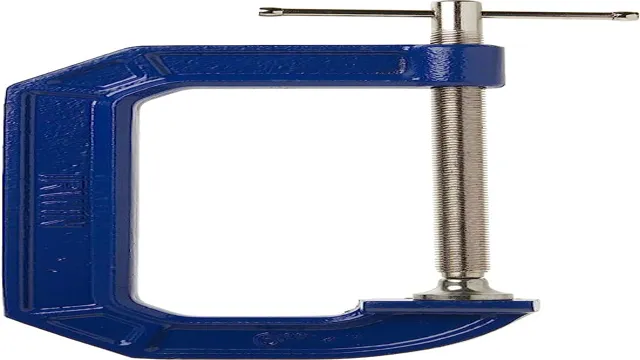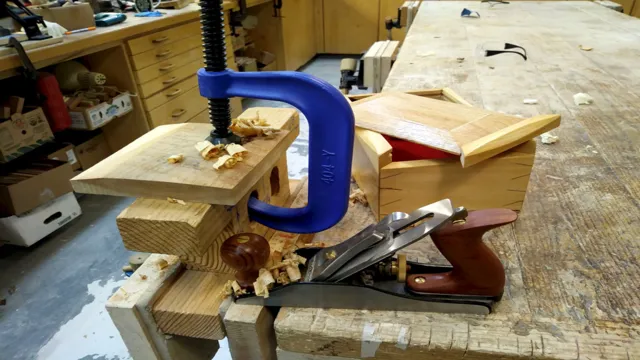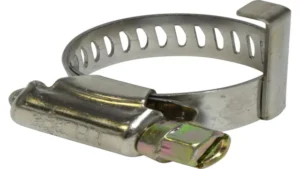Clamps are an essential tool in any handyman’s toolbox. They’re versatile and can be used for a wide range of applications, from woodworking to welding. C-clamps, in particular, are straightforward to use and manage to be a highly effective holding tool.
They come in different sizes and shapes, and each one is designed to meet specific requirements. However, before you start using a C-clamp, it’s essential to know how to measure them correctly. In this comprehensive guide, we will explore the proper method to measure C-clamps to ensure that you purchase the correct one for your specific project.
Whether you’re a DIY enthusiast or a professional, this guide has got you covered. So, let’s dive right in and explore everything you need to know about measuring C-clamps.
What are C-Clamps?
If you’re wondering how C-clamps are measured, you have come to the right place. C-clamps, also known as G-clamps, are versatile and essential tools used in woodworking, welding, metalworking, and other applications. They are measured by two factors – the throat depth and the jaw opening.
The throat depth is the distance between the screw and the frame of the clamp, while the jaw opening measures how far the clamp’s jaws can open. These measurements determine what size clamp you need for a specific job. The most common sizes are 4, 6, and 8 inches, and some designs allow for larger or smaller sizes.
When selecting the right C-clamp size, choose one that is appropriate for the thickness of the material you need to clamp. With the right size of C-clamp, you can ensure a secure hold and make any job much easier.
Definition and Uses
C-Clamps are versatile tools that can be found in any metalworking or woodworking workshop. These clamps are named for their shape, which forms the letter “C”. They are made of steel or cast iron, and consist of two jaws that can be tightened or loosened using a screw mechanism.
C-Clamps are designed to firmly hold objects in place, allowing you to work on them without worrying about movement or slippage. These clamps are commonly used to hold pieces of wood or metal in place while they are being cut, drilled, or soldered. They are also useful for holding together two pieces of wood during glue-ups or for clamping pieces of metal together during welding.
Thanks to their flexibility, durability, and affordability, C-Clamps are an indispensable tool for any DIYer or professional.

How are C-Clamps Measured?
If you’re wondering how c-clamps are measured, you’re not alone! It’s actually quite simple. C-clamps are measured based on their throat depth, which is the distance from the top of the clamp to the screw that tightens it. The throat depth determines how far the clamp can reach and how much clearance it has.
It’s important to choose a clamp with the right throat depth for your project so that it’s able to reach the area you need it to. C-clamps come in a variety of sizes, ranging from small 1-inch clamps to large 12-inch clamps. When choosing a c-clamp, you’ll want to consider the size of your project and the amount of pressure you’ll need to apply.
As with any tool, it’s important to use c-clamps properly and safely to avoid accidents.
Size Measurement
C-Clamps are a handy tool for woodworking and metalworking projects. When it comes to measuring the size of a C-Clamp, there are a few things to keep in mind. The most important measurement is the throat depth, which refers to the distance between the screw and the frame of the clamp.
This measurement determines how deep the clamp can reach into your project. Generally, throat depths range anywhere from 1 inch to several inches depending on the size of the C-Clamp. Another measurement to consider is the clamp opening, which refers to the maximum distance between the clamp’s jaws when fully extended.
This measurement determines how large of an object the clamp can securely hold. C-Clamps are typically available in a variety of sizes, from small 1-inch models to larger 12-inch or even 24-inch models. When selecting a C-Clamp, it’s important to consider the size of your project and the materials you’ll be working with.
Overall, understanding the measurements of a C-Clamp will help you choose the right tool for your needs and ensure a successful project.
Throat Depth Measurement
When it comes to C-clamps, throat depth measurement is a significant factor to consider. The throat depth is the distance from the frame of the clamp to the screw. It’s essential to find the right size of C-clamp based on the throat depth measurement.
To measure it accurately, first, measure the distance from the top of the clamp’s frame to the bottom of the screw’s thread. Next, measure the distance from the top of the frame to the end of the clamp. The difference between these two measurements is the throat depth.
Remember, the throat depth determines the thickness of the material you can clamp. So, it’s crucial to measure it accurately when selecting a C-clamp. Using the correct size of C-clamp ensures safety and gives you more control over your work.
To summarize, measure the distance from the frame to the screw’s thread and the end, then subtract the two measurements to find the throat depth. Selecting the right size of C-clamp based on the throat depth guarantees secure and efficient clamping.
Factors to Consider when Choosing C-Clamps
When choosing C-clamps, there are certain factors that need to be considered. One of the most important factors is the size of the clamp. C-clamps are measured by the width of their jaw opening, which is how much space the clamp can accommodate.
The length of the clamp also matters, as it determines the reach of the clamp. Other factors to consider include the pressure capacity of the clamp, which is determined by the screw size and design, as well as the materials used to construct the clamp. It’s important to choose a clamp made from strong and durable materials, such as steel or cast iron, to ensure maximum efficacy and longevity.
Additionally, the shape of the clamp, such as whether it is a regular or locking clamp, should be taken into account. By considering all of these factors and choosing the right size and style of clamp, you can ensure that your next project or job goes smoothly and efficiently.
Application
C-clamps When it comes to choosing the right C-clamp, there are a few factors to consider. First and foremost, you need to think about the size and strength that you require for your specific application. The size of the clamp needs to match the diameter of the material you’re clamping, and the strength required will depend on the weight of the material and how much pressure will be exerted on the clamp.
You also want to consider the design of the clamp, as some models are better suited for specific tasks than others. For example, a deep-throat design would be ideal for clamping materials in hard-to-reach areas, while a swivel-pad design would prevent the clamp from leaving marks on your material. Additionally, you should pay attention to the material of the clamp itself.
Different materials will have varying levels of hardness, durability, and corrosion resistance, so choosing the right material is crucial for the longevity of your clamp. By keeping these factors in mind, you can ensure that you choose the best C-clamp for your needs, and get the job done right.
Material and Strength
When choosing a C-clamp, it’s important to consider both the material and strength. The material used in the construction of the C-clamp will greatly affect its durability and performance. For example, a C-clamp made from cast iron may be more durable than one made from aluminum, but it may also be heavier and less portable.
The strength of the C-clamp is also an important factor to consider, as it directly impacts its ability to hold objects securely. A higher clamping force will be necessary for stronger materials and larger objects, while a lower clamping force may suffice for lighter materials and smaller objects. Ultimately, the material and strength of the C-clamp will depend on the intended application and the user’s specific needs.
By considering these factors, you can select a C-clamp that will be reliable and effective for your project.
Jaw Size
When choosing C-clamps, one of the crucial factors to consider is the jaw size. Jaw size determines the capacity of the clamp to hold a particular material. While selecting the jaw size, you need to consider the size and shape of the material you are clamping.
For instance, if you plan to clamp on round rods, choose a jaw size that can hold its cylindrical shape firmly. Ensure that the jaw size of the clamp is at least the same size as the diameter of the material. On the other hand, if you need to hold two materials securely, choose a clamp with a jaw size that can accommodate both materials.
Choosing the right jaw size prevents slippage, which can cause damages and accidents. Therefore, it’s vital to consider the jaw size when selecting C-clamps.
Conclusion
In the world of clamps, the mighty C-clamp reigns supreme. But how are these mighty tools measured? Fear not, dear reader, for the answer is simple. The size of a C-clamp is determined by the distance between the center of the screw and the edge of the frame.
So, as the saying goes, when it comes to C-clamps, size really does matter!”
FAQs
What are the common sizes of c clamps?
C clamps are typically measured by the amount of space between the clamp’s jaws, with common sizes ranging from 1 inch to 6 inches.
How do I measure a c clamp?
To measure a c clamp, use a tape measure or ruler to determine the distance between the clamp’s jaws when fully extended.
What is the maximum clamping force of a c clamp?
The maximum clamping force of a c clamp is typically determined by its size, with larger clamps having a greater maximum clamping force.
Can c clamps be used for welding?
Yes, c clamps can be used for welding since they provide a strong grip and can hold metal in place while welding.
Are all c clamps made of the same material?
No, c clamps can be made of different materials such as steel, cast iron, or aluminum alloy.
Can c clamps be used for woodworking?
Yes, c clamps can be used for woodworking since they can securely hold wood in place while sawing, drilling, or sanding it.
What is the difference between a c clamp and a spring clamp?
A c clamp has two long arms that can be tightened manually to hold objects, while a spring clamp has two shorter arms that are held together by a spring, requiring less manual effort to use.




